
Snow leopard: The solitary feline
A rare, breathtaking beauty anyone would love to get a glimpse of,
the snow leopard is considered unique among the big cats.

Even though it shares the same name with the leopard, abundantly
found in our country, you may be surprised to learn that the snow
leopard is not considered to be a close relative of the leopard, or the
Pantherine group for that matter. In fact, it is classified as a sole
member of the genus Uncia uncia.
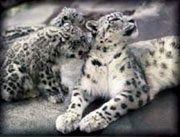
This unique species of big cats are found in Central Asia, spreading
across a wide range, north from Russia and Mongolia down through China
and Tibet into the Himalayan region of Afghanistan.
Even though the area in which snow leopards live is rather large, it
is found only in pockets within this range and have been listed as an
endangered species.
Appearance and communication
The snow leopard is also spotted like the leopard, but the rosettes
and broken-spot markings are slightly different, in that,they are well
defined and spaced further apart. It has long, woolly fur to protect it
from the cold.
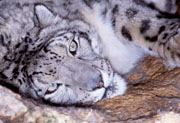
The general colour of the fur is grey with brownish yellow tinges on
flanks and lighter, often whiter fur on the belly, chest and chin areas.
It has a small, rounded head, small ears and distinctive heavy brows.

It is around 1.3 metres in length and weighs around 50-70 kg. Its
tail, which is about 900 cm long, helps the cat to maintain its balance
as it moves on rugged, snowy terrain in mountainous habitats. The tail
also acts as a coat in winter as the animal wraps it around its body
when lying or sitting.
The snow leopard's limbs are relatively short in comparison to its
body, and are supported by large, powerful paws.
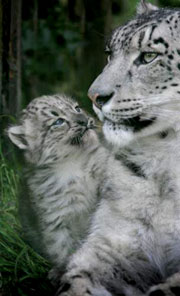
The foot pads are covered with fur for insulation against the cold.
Apart from the grey woolly coat, which is considered unique among
cats, the snow leopard is endowed with other physical adaptations for a
mountainous environment, such as, an enlarged nasal cavity and well
developed chest muscles.
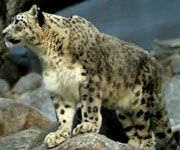
The snow leopard has sharp, round pupils like the other great cats,
and the colours range from pale yellow to greenish-grey.
Do you know that unlike most other cats, the snow leopard molts
(sheds its fur) twice a year? However, its summer coat is not as dense
as the one it grows in winter. Most of you must be aware that all big
cats roar. But, what's amazing is that the snow leopard, even though
it's a big cat, is not able to roar. What's more, it can't even purr
like the small cats.
The reason it cannot give a full, deep roar is due to the
under-development of fibro-elastic tissue that forms part of its vocal
apparatus.
The males mark their territories with scrapes, scent sprayings and
claw rakings.
Habitats
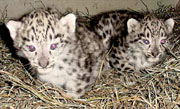
The snow leopard inhabits elevations between 2000-4000 metres, in
central Asia but is occasionally found in the lower altitudes too. In
the Himalayan region the snow leopard has been spotted at around 5500
mts.
It is mostly found in high valley ridges, rocky outcrops and mountain
passes. It also likes to roam in alpine meadows and treeless rocky
mountains.
Reproduction
The snow leopard mum gives birth to a litter ranging between 1-4 cubs
during the spring - early January to around March.
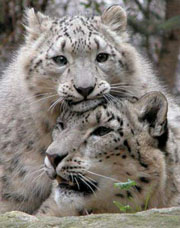
The cubs, which are born after a gestation period of approximately 98
days, weigh between 320-708 grammes at birth. They gain around 48 g per
day and stay with their mother until they are 18 months.

They are born in dens lined with fur, beneath rocks and rock
crevices. The spots on their coat are black at birth, and turn to
rosettes with age. The cubs open their eyes between 7-10 days and start
crawling after 10 days. They survive only on mum's milk for nearly two
months and start eating solids only after that.
Snow leopard cubs tend to stay together for a while even after they
leave their mum. By the time they reach 2-3 years, they are mature
enough to become parents.
These snow beauties which are hard to capture on lens as they are
rarely seen are not aggressive or harmful towards man, but
unfortunately, man is their worst enemy! Perhaps, we should join the
campaign to protect them.
Preying techniques
The snow leopard preys on wild sheep, wild goat, musk deer, gazelle
and various species of hare and birds. This well built, muscular cat can
bring down prey three times its size. It uses the natural protection of
its environment when stalking prey and is a solitary hunter. It may
share the task with its mate during the breeding season.
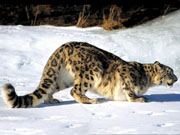
It stalks its prey for a while and when the animal is in the clear,
springs at it from as far as 20-50 feet away. It's considered to be a
superb jumper.
The snow leopard is active during the mornings and afternoons. It
kills, on average one large prey every 10 days and stays with the kill
for three to four days. It usually eats its food in a crouched position,
similar to the way your pet cat eats its meals.
Can you guess who the snow leopard's biggest enemy is? Man of course!
Hunted mainly for its beautiful fur coat, the snow leopard is now listed
in the IUCN's Red List of Threatened Animals, as an endangered species.
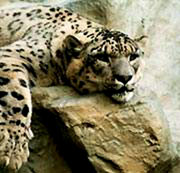
Even though it is a protected species, it is still greatly hunted and
naturalists put the number of snow leopards existing in the wilds as low
as 4,500 - 5,000. It is not hunted only for its fur, but also for its
bones. The Chinese use the bones of snow leopards as a substitute for
tiger bones, in the preparation of various medicines which are in great
demand.
Snow leopards are known to exist for around 21 years in captivity. |


